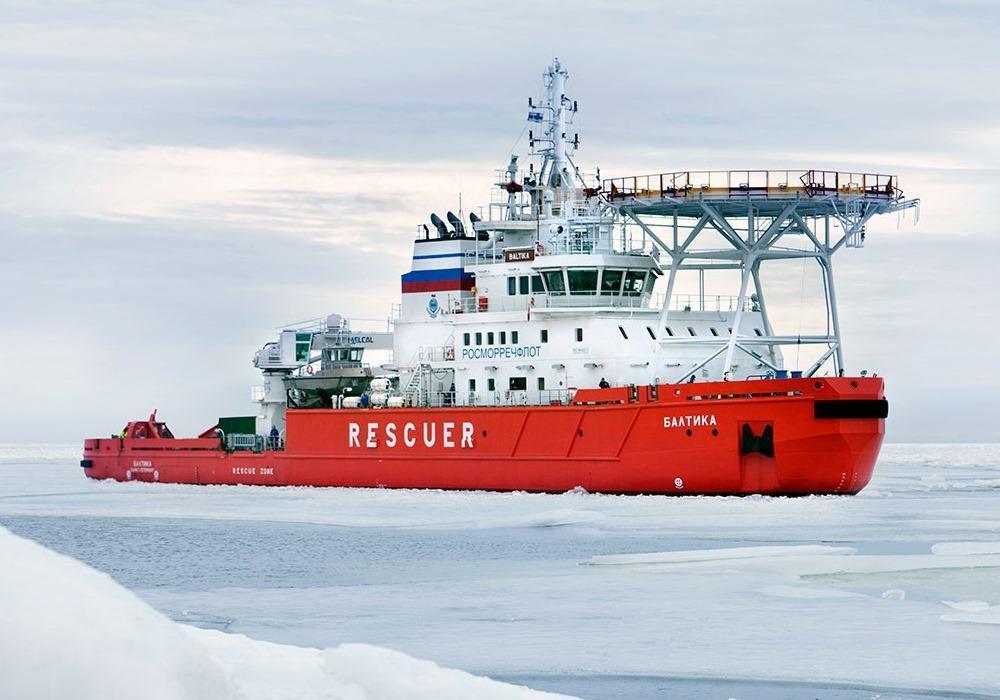Icebreakers
History, Review, Itineraries, Ships, Deck Plans, News
Icebreakers fleet

Viktor Chernomyrdin icebreaker
Current cruise: N/ARosmorport RussiaYear build 2018 / Age : 7 Passengers 90 
Yevgeny Primakov icebreaker
Current cruise: N/ASCF Sovcomflot RussiaYear build 2018 / Age : 7 Passengers 70 


Stepan Makarov icebreaker
Current cruise: N/ASCF Sovcomflot RussiaYear build 2017 / Age : 8 Passengers 42 
Fedor Ushakov icebreaker
Current cruise: N/ASCF Sovcomflot RussiaYear build 2017 / Age : 8 Passengers 42 
Gennadiy Nevelskoy icebreaker
Current cruise: N/ASCF Sovcomflot RussiaYear build 2017 / Age : 8 Passengers 42 



HMS Queen Elizabeth aircraft carrier
Scrapped: 2067IcebreakersYear build 2014 / Age : 53 Passengers 921 - 1171
Review of Icebreakers
Here you'll find an extensive list of icebreakers (icebreaker ships) operating in the regions of Antarctica (South America and Australia) and the Arctic Ocean - Russia (Asia and Europe) and North America (Canada and USA).
The world's largest icebreaker shipowners (with largest fleets) are countries with large ice-covered territories (Russia, USA, and Canada) followed by Finland, Sweden, Germany. Most icebreaking vessels are government-owned, but some are privately-owned (commercially used) ships. Some are nuclear-powered (all Russian-built), the majority being diesel-powered. Icebreaking vessel types are also Russia's new Yamal LNG carriers and oil tankers.
Icebreakers are special-purpose (assisting or research) marine vessels. Some operate on rivers, but most are ocean-going ships able to move and easily navigate through ice-covered seas. Icebreaker ships are mainly used to provide safe passing for other ships (cargo, fishing or riverboats). There are also smaller icebreaker boats and tugboats used on inland waterways (rivers and canals).
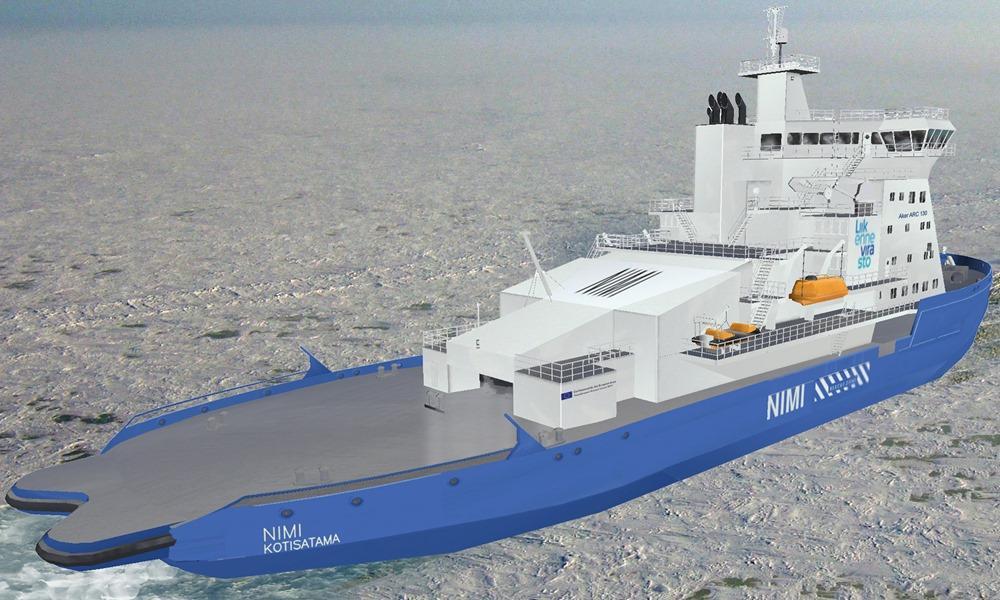
Note: The above and below computer-generated images represents the new-design Finnish icebreaking ships with ABB Azipod propulsion (total power output 19 MW / 25000 hp). The first of them (Polaris) was launched in April 2016.
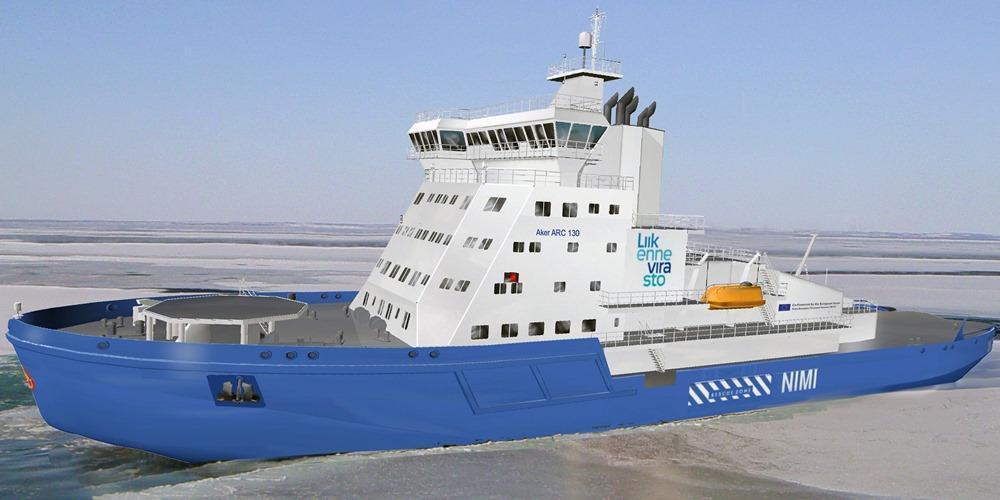
Often, icebreakers are used to free icebound ships or to tow vessels in distress. Some ice-breakers are used for polar research expeditions in Antarctica and Arctic regions. Even South Africa has such "heavy duty" ships for carrying out scientific studies there.
Today's Arctic offshore drilling operations also need icebreaking vessels to supply the drilling sites with cargo and technical equipment, and also to protect the drilling ships and the oil (gas) platforms from the ice (including from icebergs).
Icebreaker ship design
The icebreaker's design has the following most prominent features:
- ice-strengthened hull. Since the sea ice's bending (flexural) strength is low, it usually breaks easily and submerges under the hull. When the ice is thick, the ship drives its bow onto it, and the vessel's weight is used to break it. The hull is made from steels retaining their strength at low temperatures. Additionally, the hull is reinforced (constructed with thicker steels) at the bow (fore), the stern (aft) and the "ice belt" at the waterline (where the hull meets the water surface). The hull is double and painted with special polymer paints for low friction with the ice.
- ice-clearing shape. Broken ice buildups in front of the icebreaker can significantly slow it down. To prevent buildups, the ship's design requires a special hull shape to move the broken ice around the vessel. The hull is gradually sloped at the ship's bow, allowing it to ride up over the ice, so the vessel's weight to break it.
- heavy (more DWT tonnage) for their size (for more effective icebreaking)
- high output power engines. The vessel's navigation and propulsion systems have some external units (like propellers, shafts, rudder, etc) that can be damaged by the broken ice. This makes the ship's ability to propel itself quickly and to effectively clear the ice debris from its path an essential safety issue. The extra power comes from gas turbines or from the nuclear reactors of the world's largest (Russian) icebreakers.
- air-bubbling and heated water-jet systems - below the waterline, heated water is jetted to help break the ice and high-pressure air is used to move the debris out of the way.
- special water ballast system - it allows the ships to rapidly move large amounts of their ballast water, thus easily shifting weight when needed for the ice-breaking.
- propulsion system - when the ship is in motion, its rudder and propellers are protected from the ice by the so-called "ice horn" (when in reverse) and "ice knife" (when in forwards). If the propeller hits the ice, this won't stop the engine. Additionally, the propellers are made extra strong and with replaceable blades, that can be easily changed at sea. Powerful thrusters help the navigation in tight ice-packed spaces. All icebreaker ships have no stabilizers.
- powerful lights - most of the operations are done in winter (dark) conditions.
- helipad with a helicopter - for scientific works, search and rescue operations, spotting open water, guiding the ship.
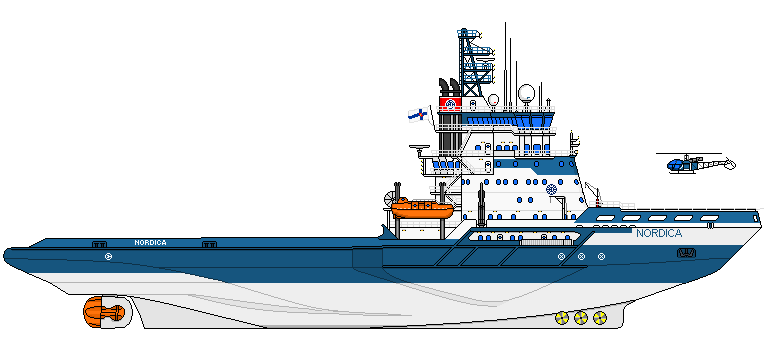
Most of the newbuilt icebreakers and many of the newly refitted ones are equipped with Azimuth thrusters (aka Azipods). These new-generation propulsion units replace the traditional "fixed propeller-rudder" system with 360-degree horizontally-rotating pods. These units give the vessel better maneuverability and an improved ice-breaking capability. Azipods additionally allow the icebreaker to move astern, thus opening a wider channel for the following ships in the convoy. On the above picture, you can see another popular ice-breaker design, with 3 bow thrusters mounted inside the hull. Below you see the Baltika ice-breaker ship design.
This is a unique project, that resulted in constructing the world's first marine vessel with an asymmetric (oblique) hull. This allows the ship to also move sideways (with a large angle of attack) for opening a wider channel for bigger ships.
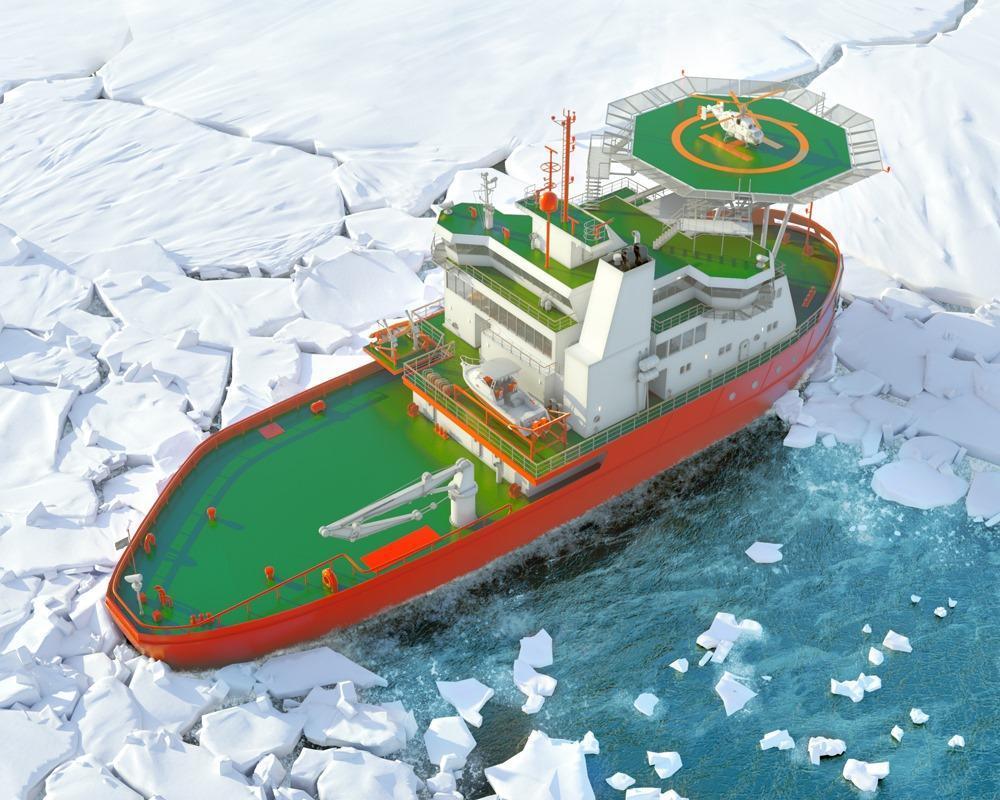
Early history
The first icebreakers were ice-strengthened sail ships used for polar exploration. Their hulls were covered outside with bands of iron, plus metal sheeting at the ship's bow (forward-most part), stern (aft-most part) and along the keel (protruding below and along the ship's central line).
Next-generation icebreakers were steam-powered. Those were wooden steamers propelled by a stern paddlewheel or by two paddle-wheels (mounted portside and starboard). One of the first such ships was constructed in the USA - named "City Ice Boat" and built in 1837 for the city of Philadelphia (Pennsylvania state). Its paddles were made of wood (reinforced with iron).
The first metal-hull icebreaker (with a rounded shape) was Russian - named "Pilot", launched in 1864 and used until 1890 for operations in the Gulf of Finland, Baltic Sea (between Finland, Estonia, and Russia). Its bow was also altered for a better ice-clearing capability.
Germany's first-ever icebreaker - named "Eisbrecher I" - was built with the Pilot's design and used for operations on Elbe River. The world's first polar icebreaker was built in England. Named "Yermak", the ship was built in 1897 under a Russian Navy's contract. Its weight was 5000 tons, with steam engines delivering a 10000 horsepower (~7450 kW) output. This icebreaker was used until 1963, making it the world's longest-serving.
Canada's first icebreakers were used on Saint Lawrence River (connecting the Atlantic Ocean with the Great Lakes). The first Canadian Arctic icebreaker ships were built in 1930 (CGS McLean) and 1952 (CGS D'Iberville).
Diesel icebreakers
The first diesel-powered icebreaker ship was Swedish - the 4330-ton "Ymer" (1933-1977). Its diesel engine delivered 9000 horsepower (~6700 kW) output. The ship had 2 stern propellers and 1 bow propeller. Finland's first diesel icebreaker was named "Sisu" (1939-1976). After their decommissioning, both were replaced their much larger versions Ymer (1977) and Sisu (1976). The new-design icebreakers featured a short and wide hull (with a rounded bottom) and powerful diesel-electric propulsion with all 3 propellers (2 at the stern, 1 at the bow).
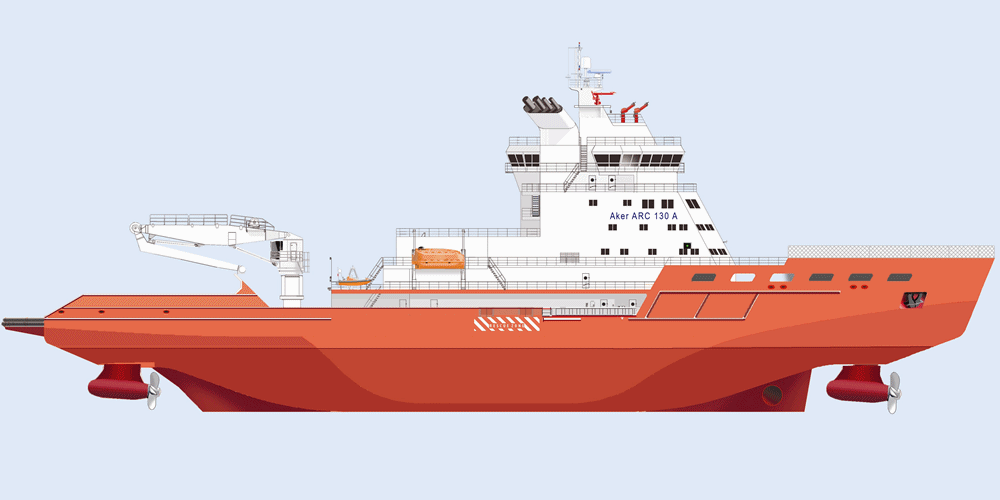
The first Canadian diesel icebreaker was named "CCGS Labrador" (1952-1987, without a bow propeller). The larger and more powerful version was named "CCGS John A Macdonald" (1960-1994, with power output 15000 hp (~11,2 MW) and 3 propeller shafts. The country's largest and most powerful icebreaker was named "CCGS Louis S St Laurent" (1969-2030). Its original steam plant delivered 27000 hp (~20 MW). During its 1993 refit, the boat got a new powerplant consisting of 5x engines, 3x diesel generators, 3x electric motors.
The world's most powerful (non-nuclear) icebreaking ships are the USCG vessels Healy (2000) and Mackinaw (2006). They have diesel-electric propulsion with a powerplant of 6 marine diesel combined with 3 gas turbines. The power plants generate ~18000 hp (~13 MW) output, and their gas turbines produce a combined ~60000 hp (45 MW) output.
Nuclear icebreakers
All still functioning nuclear-powered icebreaker ships are Russian, most of the theme being built during the Soviet Union (USSR) time. The world's first-ever was named "NS Lenin" (1959-1989, now a museum ship in Port Murmansk) and was a civilian vessel. The second ("NS Arktika"/1975-2008) was the world's first to reach the Geographic North Pole (August 17, 1977).
In 1993 was launched the world's ever-largest icebreaker 50 Let Pobedy (translated "50 Years of Victory") but under the name "NS Ural". Until 2017, this Arktika-class (Project 10520) was the world's most powerful icebreaker, equipped with 2x OK-900A nuclear reactors (generating 458630 hp / 342 MW total output).
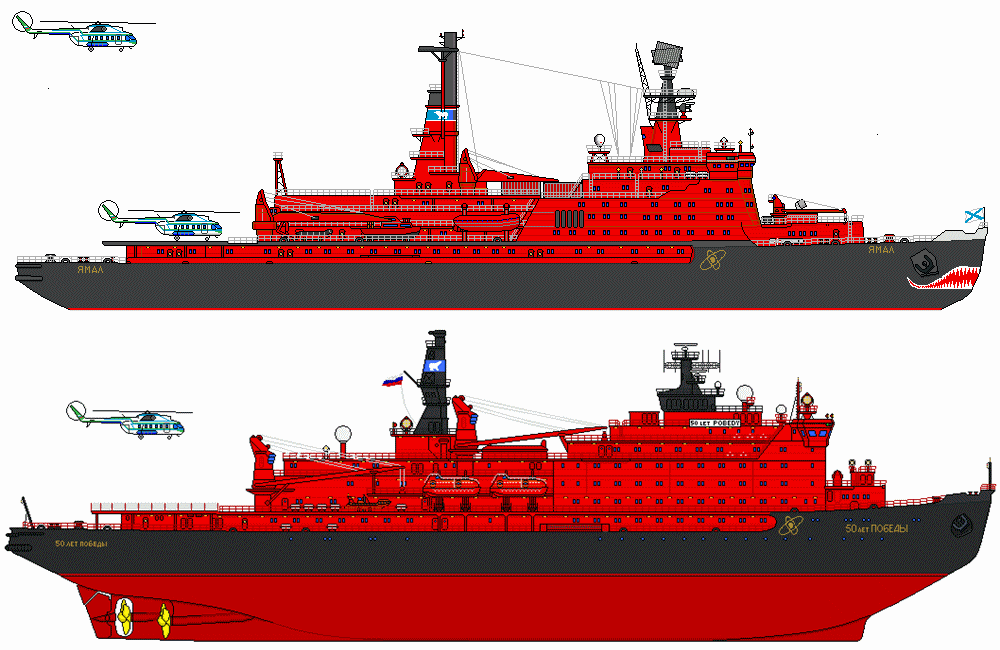
Russia's nuclear fleet of icebreakers is used exclusively in the Arctic Ocean, to escort merchant ships and to assist research stations floating in the waters north of Siberia. These nuclear ships are also used for scientific and cruise expeditions and must sail in ice-cold waters in order to effectively cool their reactors.
Floating nuclear powerplant "Akademik Lomonosov"
The world's ever first "floating nuclear powerplant" (nuclear reactor at sea) was built in Russia - launched in 2010 (June) and commissioned in 2019 (July). The vessel "Akademik Lomonosov" is a floating (non-self-propelled) barge and a power-generating unit that can be connected (via cables) to any offshore or onshore infrastructure to supply it with electricity.
The new technology is unique and has no analogs worldwide. The floating powerplant was designed to deliver electricity to major Russian Arctic port cities and industrial enterprises (including offshore gas and oil platforms). It allows the power station to become a marine vessel (displacement tonnage 21,500 tons) manned by a crew of 69.
However, unlike the icebreakers, this vessel has to be towed to its destination. The barge has length 144 m (472 ft), width 30 m (98 ft), combined power output (2x KLT-40C / modified nuclear reactors) 70 MW (electricity) or 300 MW (heat) and is owned by Rosatom. Both reactors were assembled in Nizhny Novgorod.
Russian icebreakers
Note: You can see CruiseMapper's list of all Russian icebreaking vessels in the "Itinerary" section (above, next to "Review")
Rosmorrechflot is Russia's Federal Agency of Sea and River Transport. AARI is an abbreviation for Russia's "Arctic and Antarctic Research Institute".
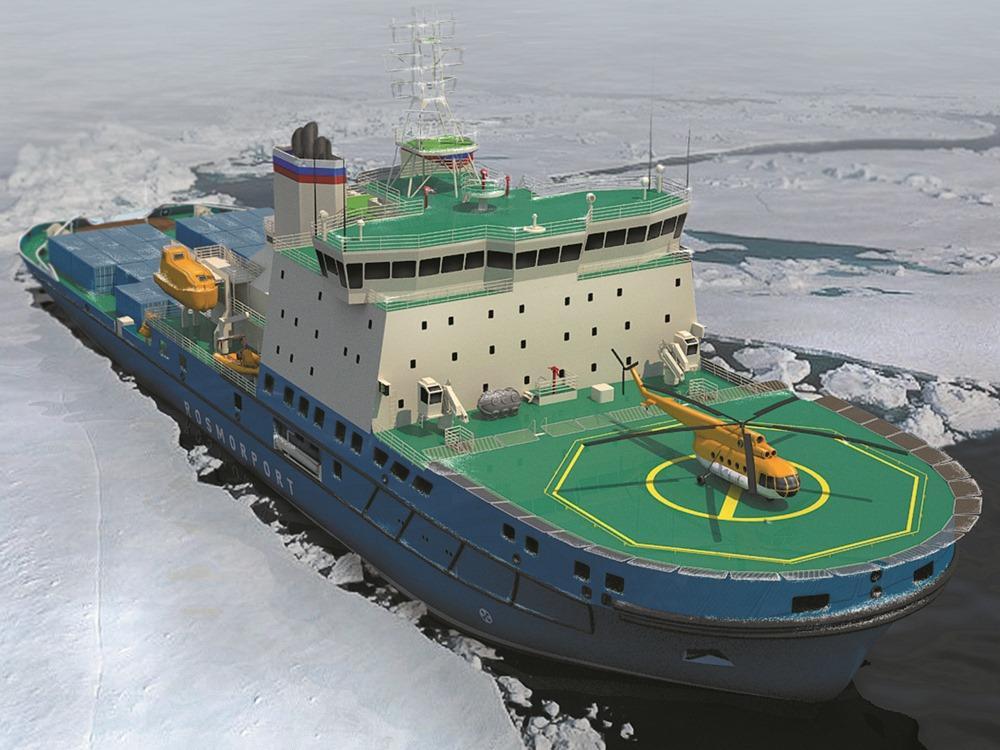
Russia's leading icebreaker shipbuilding yard is the Baltic Shipyard (Baltiysky Zavod Ordzhonikidze / Балтийский завод Орджоникидзе). It is one of the oldest in Russia (founded 1856). The shipyard is part of the Russian joint stock company USC (United Shipbuilding Corporation / Объединeнная судостроительная корпорация).
Baltic Shipyard is located on the Vasilievsky Island (St Petersburg). It is the shipyard that built most of the Soviet Union's nuclear icebreakers. There is currently being built the Viktor Chernomyrdin ship (the yellow-greenish rendering image above). This is the world's largest and most powerful diesel-engined icebreaker (length 482 ft / 145 m, deadweight 22260 DWT). Next photo shows a diesel-powered ship design.
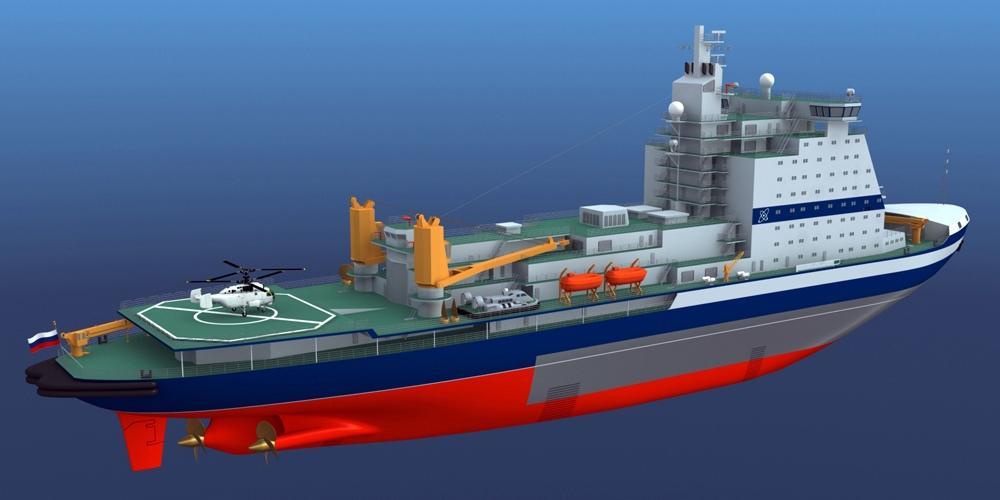
The largest icebreakers in the world (nuclear-powered, Project 22220) are NS Arktika (2020), Sibir (2021), NS Ural (2022), NS Yakutia (2024), NS Chukotka (2026), NS Stalingrad/fka Kamchatka (2028) and NS Leningrad/fka Sakhalin (2030). "NS" stands for "nuclear ship".
Viktor Chernomyrdin (2018, Project 22600) is currently the world's biggest diesel-powered icebreaker.
Next YouTube video (official release by Росатом Госкорпорация) was published on June 19, 2018, and titled "Самый большой атомный ледокол" (world's largest nuclear icebreaker).
Next image shows the design of the new "Project 21900" Russian icebreakers. A total of 5 vessels were built between 2008-2016. Their names are Moskva (2008), Sankt Peterburg (2009), Vladivostok (2015), Murmansk (2015) and Novorossiysk (2016).
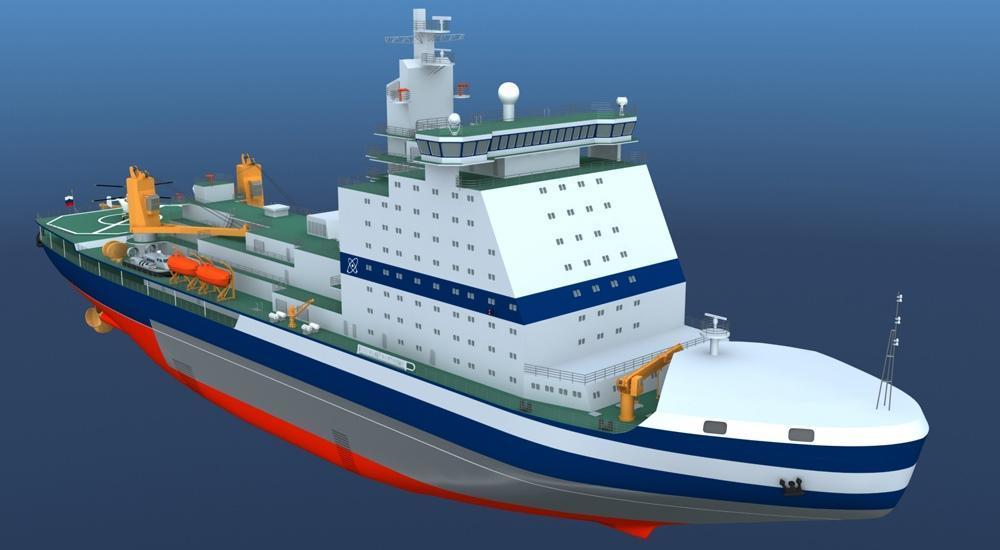
Below is shown the "Project 22220" ship design of Russia's largest nuclear icebreakers currently being under construction in St Petersburg. Their design was developed in 2009 by the Russian research company "Central Design Bureau Iceberg" (St Petersburg-based). This company is a subsidiary of the OJSC company DTsSS ("Dalnevostochnyi Tsentr Sudostroyeniya I Sudoremonta", translated "Far East center for shipbuilding and ship repairs") based in Vladivostok (Primorsky Krai, Russia).
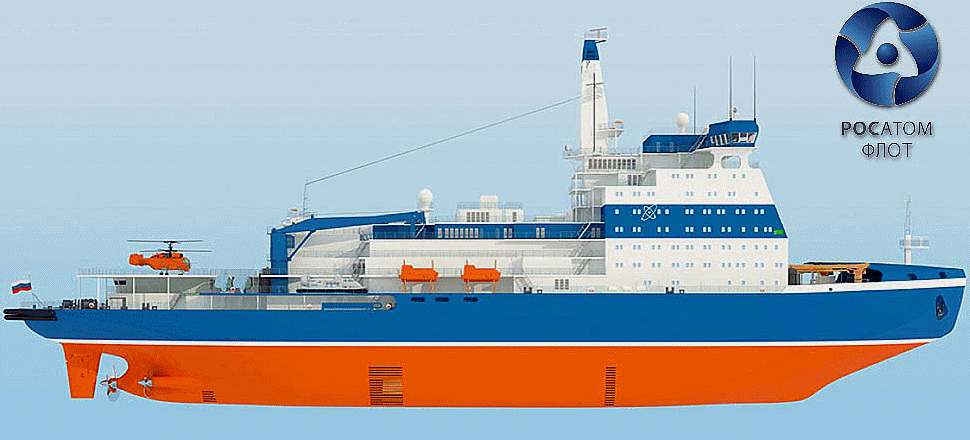
Yamal LNG vessels (ice-breaking tanker ships)
Russia's "Yamal LNG" project (yamallng.ru) included designing and building Arctic icebreaking LNG carriers. By this project, the Korean shipbuilder DSME (Daewoo) built a series of 16 such vessels.
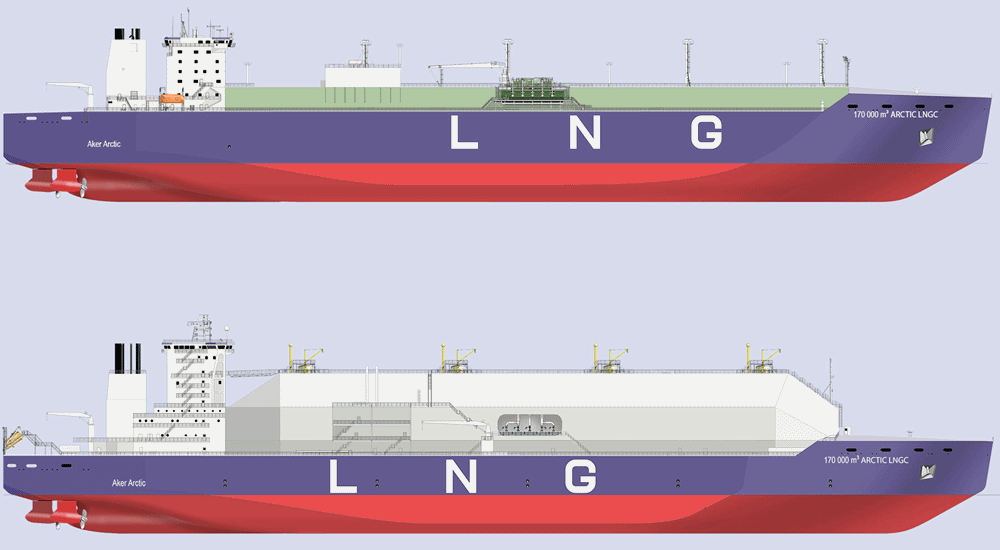
The ice-breaking gas carriers have the following vessel particulars:
- dual-acting hull form - ice bow (for navigating forward in thin ice and open sea ) and heavy ice-breaking aft (for navigating astern in thick ice)
- hull steel - prepared for operation in temperatures down to -52 Celsius (-61 Fahrenheit)
- strengthened hull (with ice belts - forward and aft)
- ice-breaking capacity - 2,5 m / 8 ft
- LOA length - 299 m / 980 ft
- width - 50 m / 164 ft
- draft - 12 m / 39 ft
- pod propulsion (3 azimuth thrusters with ~45 MW power output)
- 2 engine rooms with marine diesel-electric power plants
- LNG capacity - 172,000 m3
- each ship has 4-membrane LNG tankers type "GTT NO 96"
- flag-state / registry - Russia
- Russian Register standard - RMRS ARC7
- Bureau Veritas standard - Polar Class 3 and 4
- shipbuilder - DSME (Daewoo Shipbuilding), Okpo yard
- shipbuilding cost - USD 300 million (GBP 233 million)
- ownership - MOL (50%) and COSCO Shipping (50%)
These ships are operated by the companies Sovcomflot (1), MOL (3), Teekay Corporation (6) and Dynagas (5). On November 2, 2017, MOL (Mitsui OSK Lines) announced that China's COSCO Shipping Corporation takes 50% stake in MOL's wholly-owned subsidiary that owns 4 carriers serving Yamal LNG (LNG Dubhe, LNG Merak, LNG Phecda, LNG Megrez). Builder is Hudong-Zhonghua Shipbuilding (China).
The first of all 3 newbuilds for MOL and China COSCO - LNG-carrier Vladimir Rusanov - was delivered on December 21, 2017. It started long-term charter operations on March 27, 2018. The 2nd and 3rd vessels were delivered in September 2018 and September 2019.
An icebreaking LNG carrier transports gas from Hammerfest (Norway) to Boryeong (South Korea) in just 19 days - or 30% quicker than through Suez Canal.
Ships' owner and an operator is the company "Yamal LNG". This is a joint venture between PJSC NOVATEK (Russia's largest LNG producer, 50,1%), Total SA (multinational, 20%), CNPC (China's largest oil and gas producer-supplier, 20%) and Silk Road Fund (China state-owned investment fund, 9,9%).
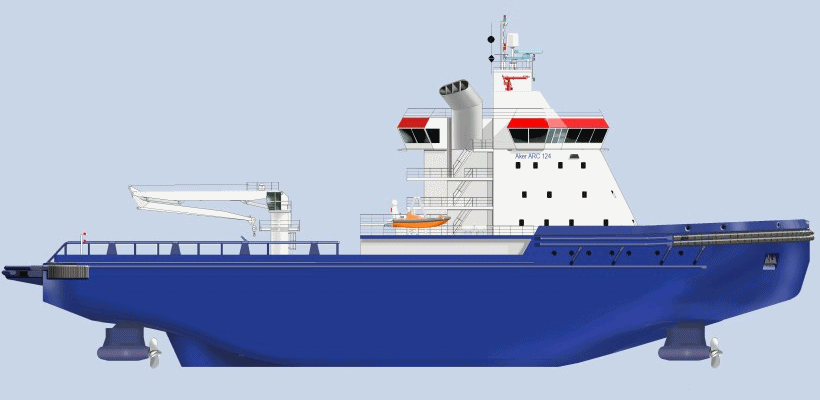
By the Yamal LNG project:
- More than 200 wells were drilled.
- 1x gas transshipment terminal was built.
- 3x LNG trains were constructed, (each with 5,5 million tons annual gas capacity).
- 15x ice-breaking LNG tankers were built.
ARC7-class LNG carriers were launched in 2016 (Christophe de Margerie), in 2017 (Boris Vilkitsky, Fedor Litke, Eduard Toll), in 2018 (Rudolf Samoylovich, Vladimir Vize, Vladimir Rusanov, Georgiy Brusilov, Boris Davydov, Nikolay Zubov), in 2019 (Nikolay Yevgenov, Vladimir Voronin, Georgiy Ushakov, Yakov Gakkel).
Yamal LNG ships are based at Port Sabetta (Yamal Peninsula, Russia), western Siberia (at Ob River's estuary). The USD 27 million facility is ice-bound 9 months in the year. The project ensures the shipping of Russian Arctic natural gas (from the South Tambey gas field) to Europe and Asia.
On May 1, 2018, was the first LNG transhipment from Sabetta (Yamal) to Zeebrugge (Belgium) from an icebreaking carrier to a conventional LNG carrier. The gas transfer (from MS Eduard Toll to MS Pskov) was via Fluxys pipeline network and done at quays 615 and 616 ((outer port). The 2015-signed contract with Fluxys terminal constitutes an annual LNG transhipment of 107 loads (from ice-breaking vessels) to conventional vessels.
On December 11, 2018, NOVATEK announced that Yamal LNG reached its full capacity with three operational LNG trains (2nd and 3rd trains were inaugurated 6 months ahead of schedule). Yamal LNG is comprised of three liquefaction trains, each with capacity 5,5 MTPA (Million Metric Ton Per Annum), or total 16,5 MTPA. For 1 year (December 2017-2018) were produced and delivered approx 7,5 million tons of LNG.
The first cargo from Yamal LNG to Japan (TEPCO Ohgishima LNG Terminal, Yokohama) was delivered in July 2020 - via the Northern Sea Route and the ARC7-class tanker Vladimir Rusanov.
In early-November 2020, ABB Marine & Ports signed with Daewoo Shipbuilding a USD 300+ million contract to supply Azipod (power-propulsion) packages for 6 newbuild LNG carriers to be deployed on the Northern Sea Route. The package includes 3x 17 MW units (total power output 51 MW / 68,400 HP) per ship, which allows safe navigation through 2,1 m thick ice. Upon delivery (starting 2023), the 6 icebreaking LNG carriers (each with max LNG capacity 170,000 m3) will serve NOVATEK's Arctic LNG 2 project.
Russian ice-breaking LNG tankers
In June 2017 was launched the LNG tanker "Christophe de Margerie" (owned by SCF-Sovcomflot). The vessel became world's first ice-class LNG tanker. It is designed for seasonal navigation on the Northern Sea Route (Russian Arctic, July through November) without an icebreaker escort. The voyage between Asia and Europe takes just 15 days (via Bering Strait), or half the time needed on the route via Suez Canal.
- In July 2018, Christophe de Margerie made Northern Sea Route record crossing (eastward, Sabetta to Cape Dezhnev), covering 4370 km (2720 ml) for 7 days 17 hours. The vessel navigated without icebreaker support, at an average speed 12,8 knots (24 kph / 15 mph). The full voyage Russia-China (Sabetta to Tangshan) took 18,5 days.
- Inaugurated in December 2017, Christophe de Margerie ship has ice-breaking capacity 2,1 m, propulsion power 45 MW (comparable to nuclear-powered icebreakers), 29 crew (including 13 officers).
In late-September 2017, Sovcomflot (SCF Group), Rosneft (STLC) and Zvezda Shipbuilding signed an agreement for the construction of all 5x Aframax icebreaking tankers to serve crude oil and oil products export shipments (year-round operations) in Northern Europe's and Asia's arctic regions. Each of the 114,000 DWT ships was built by Zvezda Shipbuilding partnering with HHI (Hyundai Heavy Industries, Korea). Vessels' owner and operator is Sovcomflot-SCF, with deliveries scheduled for 2021. These icebreaking LNG-powered oil tankers were designed to use LNG as primary fuel and also to comply with IMO's newest regulations and standards (effective since 2020) concerning SOx, NOx and CO2 emissions.
In October 2017, Rosnefteflot signed with Zvezda Shipbuilding agreements for the building of all 10x Arctic shuttle oil tankers. At the same time, Rosnefteflot (a subsidiary of Rosneft / Russian oil company majority state-owned) signed with Taimyrneftegaz a 20-year time charter agreement for the 10x Aframax oil tankers.
- builder - Zvezda Shipbuilding Complex
- ice-class ARC7 / ICE-1A
- LOA length 250 m (820 ft)
- width 44 m (144 ft)
- deadweight 114,000 tonnes
- ice-breaking capacity up to 1,8 m (6 ft)
- lowest operational temperature -45 C (-49 F)
- 10x ship orders (vessel launch/delivery year) - Vladimir Monomakh (2020), Nursultan Nazarbayev (2022)
These tankers transport crude oil produced at Paiyakhskoe field (Enisey River) on both eastbound and westbound itineraries along Northern Sea Route. On September 11, 2018, was the keel-laying of the 1st Aframax oil tanker.
In June 2019 (during SPIEF / "St Petersburg International Economic Forum") was officially established the joint venture company "Maritime Arctic Transport LLC".
- The 4-party agreement was signed by NOVATEK, Sovcomflot, COSCO SHIPPING Corporation Ltd (China) and Silk Road Fund Co Ltd (China, 2014-founded). Maritime Arctic Transport manages the icebreaking LNG tanker fleet (existing and new ships) serving all current and future (NOVATEK-planned) projects - Yamal LNG; Arctic LNG 2 (Gydan Peninsula), others.
- On June 6 was signed the 4-party agreement for building and management of seaports along Russia's NSR (Northern Sea Route). The parties included Russian Direct Investment Fund (RDIF / Russian Federation's sovereign wealth fund investing in Russian assets together with foreign investors), ROSATOM (NSR's infrastructure operator), Norilsk Nickel (world's largest producer of palladium and highest-quality nickel) and DP World Dubai (one of world's largest port and logistics operators).
- Project's focus is linear transportation of TEUs and bulk cargoes along the NSR via ice-class fleet (plus assisting icebreakers) and developing route's port infrastructure.
In September 2019, SCF and NYK Line signed USD 176 million non-recourse loan for financing two icebreaking LNG carriers for the Sakhalin-2 project. The 8-year credit facility was signed with 3 banks - Japan's Sumitomo Mitsui Banking Corporation (via SMBC Bank EU AG), France's Societe Generale) and Japan's Shinsei Bank Ltd. The sisterships Grand Aniva (2008) and Grand Elena (2007) are jointly-owned and operated by SCF and NYK Line. They both transport LNG from homeport Prigorodnoye (Sakhalin Island) to Asian ports (Japan, South Korea, China). Regular gas shipments from Sakhalin-2 started in March 2009. For 10 years, these ships delivered 46,5+ million m3 of LNG via 325 Okhotsk Sea crossings.
On November 4, 2019, SCF Group and VEB.RF (2007-founded Russian state development corporation / financial group) signed a lease financing agreement for the first in a series of icebreaking LNG tankers for the Arctic LNG 2 project. At the same time, SCF signed with NOVATEK a long-term time charter deal for this ship. These new class LNG carriers are designed for year-round Arctic Ocean operations and will be Russia-made (constructed at Zvezda Shipyard in Bolshoy Kamen (Russian Far East). Hull's max icebreaking capacity is 2,5 m.
On June 15, 2021, at Zvezda Shipbuilding started the construction of the first of all 15x ARC7-class Arctic LNG carrieriers ordered by Sovcomflot (SCF Group).
- The first vessel is owned by SCF, the remaining 14x - by SMART LNG (Sovcomflot-NOVATEK joint venture).
- All carriers were planned for deliveries in 2023-2025.
- Details include LOA length 300 m, width 49 m, LNG capacity 172,600 m3, 3x azimuth thrusters (total propulsion power output 45 MW).
Russian icebreaking oil tankers
At the end of October 2015, the shipbuilder Samsung (South Korea) started building a series of 6 icebreaking tankers by the project "42К Arctic Shuttle Tanker" surveyed by RS (Russia's Maritime Register of Shipping). The order was placed by SCF Group - owner of 3 of the ships, which operator is Sovcomflot. Vessel's particulars are:
- ice-breaking capacity - 2,1 m / 7 ft
- LOA length - 248 m / 814 ft
- breadth / width - 34 m / 112 ft
- depth - 15 m / 49 ft
- draught / draft - 9,5 m / 31 ft
- Deadweight Tonnage (DWT) - 42,000 tons
- flag-state / registry - Russia
All named after famous Russian arctic explorers, these 6 vessels are of dual-class (RS and LR), intended for high-latitudes and year-round operations at extreme temperatures (down to -45 Сelsius). Their purpose is crude oil shipping from Gulf of Ob (aka Ob Bay, at the mouth of Ob River, Kara Sea). Completion and delivery of the first ice-breaking tanker were scheduled for June 2016. The whole series was completed in 2017.
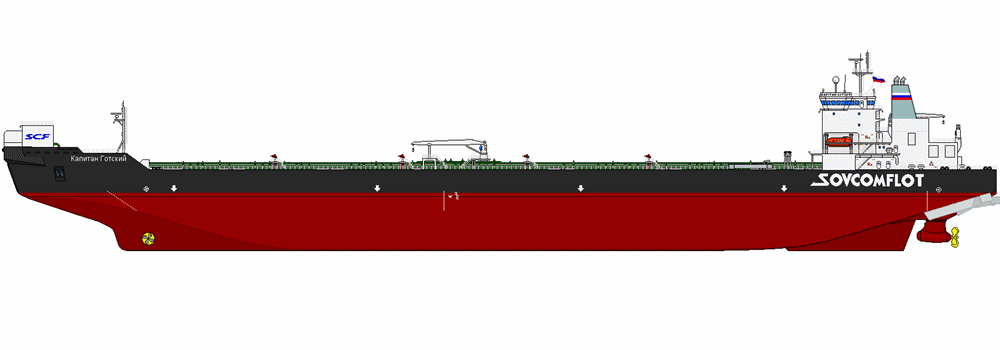
SCF is the owner and Sovcomflot the operator of MS Kapitan Gotsky - 2008-built oil tanker with DWT 70,000 tons, ice-class 1A (strengthened hull.
Russian icebreaking container-cargo ship
A truly unique vessel is the Russian nuclear icebreaker NS Sevmorput (built 1988). Its cargo capacity is 74 lighters (flat-bottomed barges of 300 tons capacity each) or 1328 TEU containers (TEU = twenty-foot equivalent unit).
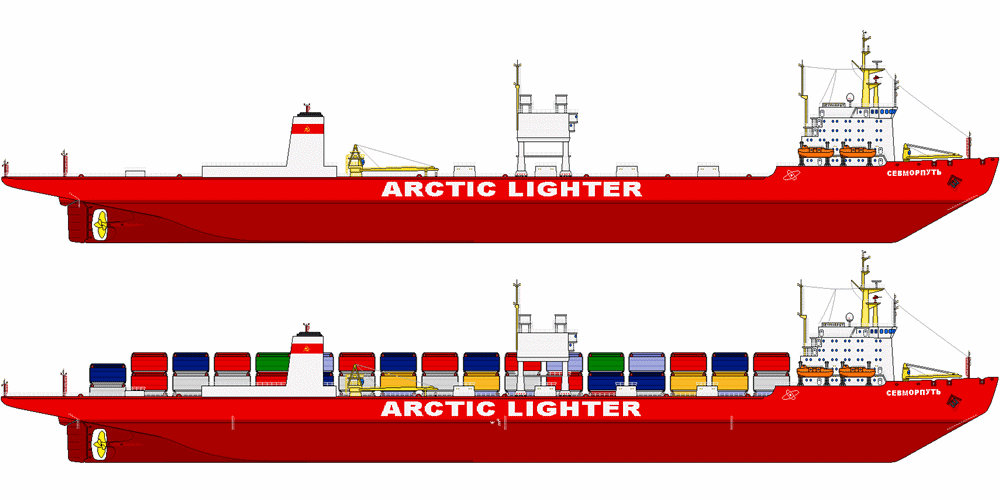
This is currently the world's only nuclear merchant ship - operational and still in service. Sevmorput is also the newest of the all 4 nuclear cargo ships in the world ever constructed - together with:
- NS Mutsu (Japan, launched 1972, decommissioned 1992), rebuilt as ocean observation vessel named "Mirai"
- NS Savannah (the USA, launched 1962, decommissioned 1972), now a museum ship
- NS Otto Hahn (Germany, launched 1968), scrapped 2009
Among the Russian ice-breaker cargo vessels are:
- FESCO Vasily Golovnin (general cargo ship, 298 TEU-containers)
- FESCO Magadan (Arc4-class containership, 822 TEUs) - from homeport Magadan connects with Vladivostok and Vostochny.
- MS Norilskiy Nickel - diesel-powered icebreaking containership designed and built in Germany. This carrier operates independently on a year-round schedule in Siberia - without the assistance of an icebreaker.
- MV Nunavik (bulk carrier)*
In early-November 2018, MSCO (Murmansk Shipping Company) and Sibanthracite Overseas AG (a subsidiary of Russia's largest coal company VostokCoal) announced their 5-year agreement (2019-2024) for coal deliveries along Northern Sea Route. The year-round service is via MSCO-owned, ice-class bulk carriers.
Russian Arctic research ship platform
At the end of March 2018, Russia announced plans to build a research ship platform for year-round autonomous operations in the Arctic region.
- The self-propelled platform has the highest ice-class hull and capacity to operate autonomously in Arctic waters for up to 3 years,
- The "North Pole" ship features nuclear powerplant, helicopter-landing platform, latest maritime and research equipment. The new ship platform will replace all Russian research stations currently based on drifting ice floes. USSR (later Russia) has floating Arctic research stations since 1937, excepting the break 1991-2003.
- The EUR 98 million shipbuilding project is a joint venture with Roshydromet (Russia's federal meteorological agency). Construction works start in 2019.
Australia-UK-Canada-USA icebreakers
Follows the list of UK and US icebreaker ships. Some of them (prefixed with "USCGC" and "CCGS") are in service for the USCG ("United States Coast Guard") and CCG ("Canadian Coast Guard") in the Alaskan and Arctic waters (North America). "NSF" states for "National Science Foundation" (US Government's research and education agency). "BAS" states for "British Antarctic Survey" (UK Government's research organization).
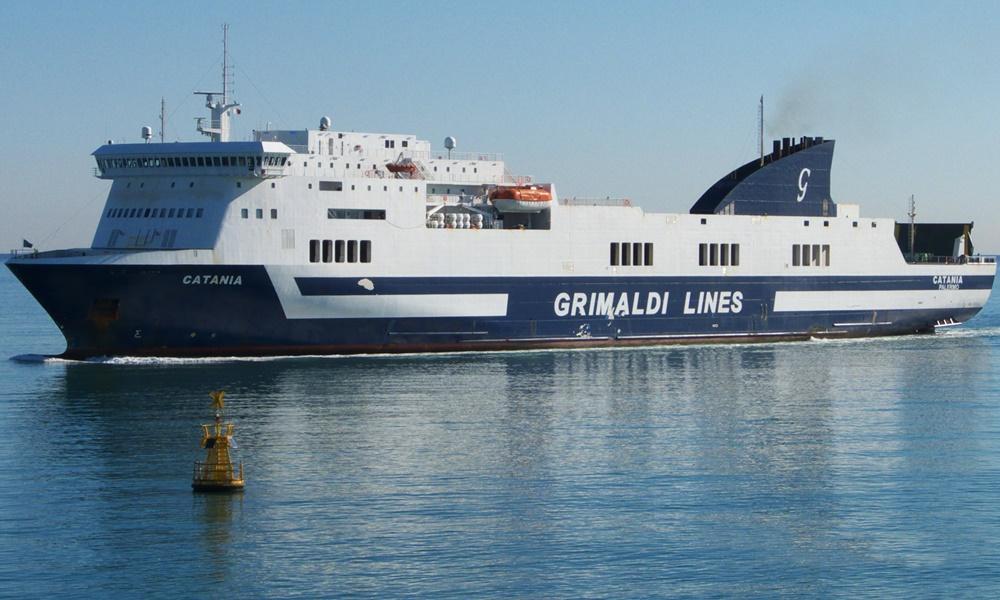
US and Canadian Coast Guards provide critical icebreaking services to commercial ships and ferries accessing US-Canadian ports during wintertime. The CCG additionally supports re-supply activities in the Canadian Arctic during summer, thus supporting year-round shipping in Eastern Canada, St Lawrence Seaway and Great Lakes.
On January 13, 2016, the USCG released requirements for 2x new heavy icebreakers (Polar Sentinel/2025, and Polar TBN/2026) at budget cost ~USD 1 billion per unit. There was a meeting with the interested companies in March 2016. For comparison, while the USA has only 2 operational icebreakers (Healy, Polar Star), Russia has 42 (with another 12 planned or already under construction) and China has 2. The USCG warned that as the Arctic Ocean opens to tourism, mining, and oil drilling, the US risks not having enough capacity for search and rescue ops and also for oil spill response missions.
On May 22, 2019, Canada's Prime Minister announced a Government investment of CAD 15,7 billion (USD 11,8 billion) to renew CCG's fleet with up to 16 multi-purpose icebreaking vessels (to be built by Seaspan/Vancouver Shipyard) plus 2 offshore patrol ships (to be built by Irving Shipbuilding/Halifax Shipyard). In early-August 2019, was announced a program for procuring 6 new (Canada-built) icebreakers to replace the current CCG fleet's aging vessels.
(NEW) Australian Antarctic icebreaker
In October 2015, the Government of Australia revealed a new icebreaker ship design and announced a contract for building a marine science research and supply ice-breaking vessel. Classified as ASRV ("Antarctic Supply Research Vessel") it will allow extended access to Antarctica and Southern Ocean. The ship's equipment includes a multibeam echosounder (for seabed mapping), a stern helipad, 3 cargo cranes. Portable research laboratories will boast the latest technology equipment.
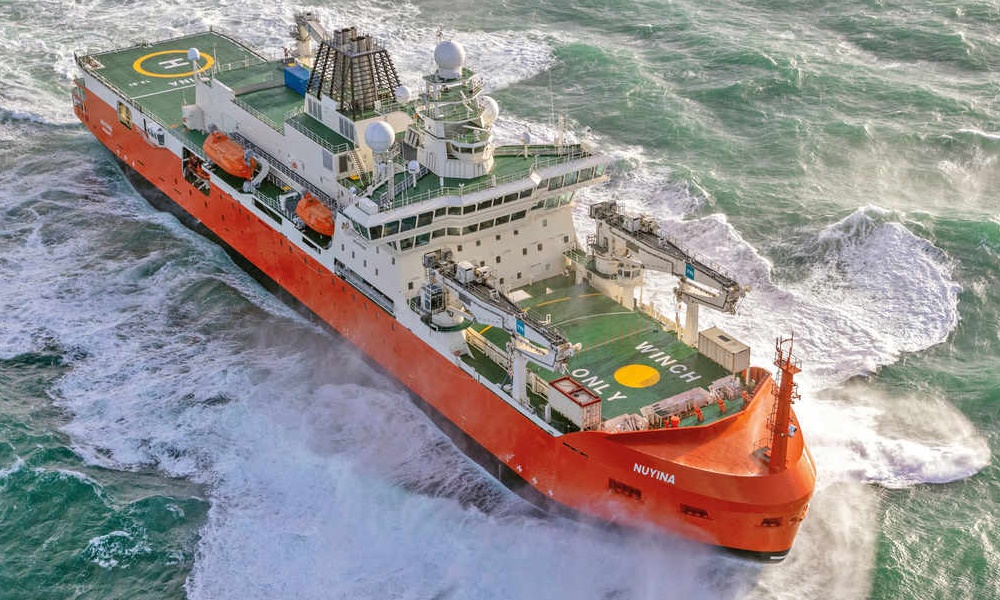
Ship design is by the Dutch company Knud E Hansen AS (specializing in naval architecture and marine engineering). The shipbuilder is the Holland-based company Damen Shipyards Group.
The contract was signed with the UK-based DMS Maritime - Australia's largest maritime services provider (part of Serco Group). The new Antarctic icebreaker shipbuilding project has a budget of AUD 1 billion (USD ~720 million). The ship will be commissioned in April 2020.
About 1/4 of the world's oil and gas resources lie beneath the Arctic Ocean waters. The list of states that already laid claims to Arctic territories includes Russia, Norway, Denmark (because of Greenland), Canada and the USA. Note: Most of the technical information on this page is sourced from Wikipedia. To share our icebreakers ship tracking hub page, use the social media button links.
n March 16, 2018, Aker Arctic signed a deal with ICEYE ("synthetic aperture radar" SAR provider) for developing and providing microsatellite data related to sea ice conditions. The data is provided to Aker Arctic serviced vessels navigating in icy conditions (icebreaking and polar expedition ships). The new SAR satellite data combined with maritime-gathered data and analytics provides cost-efficient service to Aker Arctic customers. During the project's 1-year pilot phase was developed and tested the new services. In 2018, ICEYE launched 2 new microsatellites (ICEYE-X1, ICEYE-X2) specifically designed for this service. ICEYE announced the company's plans to build a network of 18 SAR satellites for accurately imaging the entire planet every few hours.
zzz
Itinerary of Icebreakers
Since the fall of the USSR, many icebreakers (including nuclear-powered) are also operated as cruise ships in the Arctic Ocean - to carry cruise passengers to the North Pole. The itinerary lasts about 20 days, with prices reaching up to USD 25000 per person. Most of the modern Russian icebreakers ("ledokol" / "ледокол" in Russian) have a separate cabin deck for tourists.
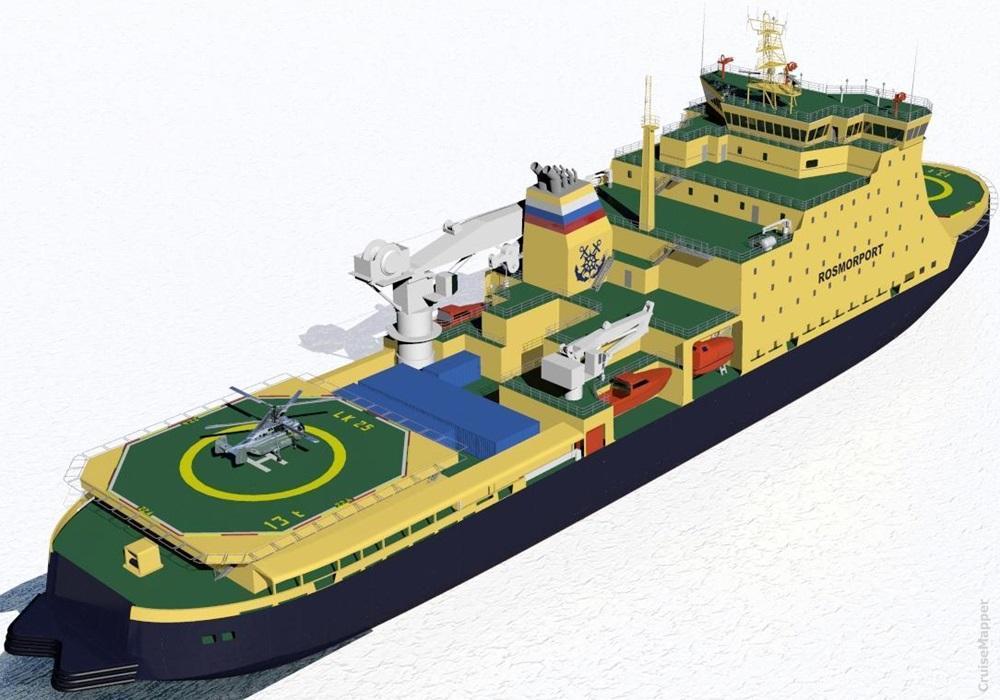
Follows the complete list of Russian icebreakers in active service. A small but most unusual cruise travel niche, the ice breaker ship travel's popularity prompts most of the Russian ice-breaking vessels to be also operated as cruise ships under charter by both domestic and foreign operators.
These unique ships operate on itineraries in Russia's Arctic Ocean waters, with departures mostly from Europe, but also from Far-East Russia (Asia) ports. Notes: In brackets are shown the ship owners. All nuclear ships are state-owned and managed/operated by Rosatom (a state corporation) through Atomflot. Rosmorport is a state-owned company (a Federal State Unitary Enterprise).
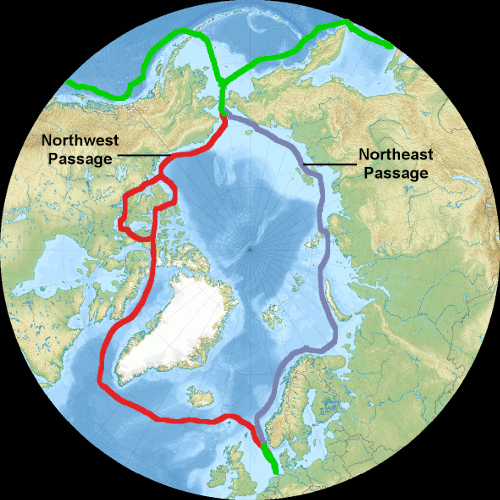
On the map here you can see the routes of the two classic Arctic Ocean expedition cruise itineraries. These ice-breaker ship travel itineraries usually start in Europe. The Northeast Passage itinerary is along Russia's coast, while the "Northwest Passage" itinerary includes Greenland, Canada and the USA (Alaska).
Most icebreaker ships are used to keep the ice-covered shipping trade routes open. The regions where icebreakers are most needed are Baltic Sea, Great Lakes, Saint Lawrence Seaway, the Arctic Sea Route. There, icebreakers escort cargo vessel convoys through the ice-packed waters.
On the next map, you can see all major destination ports of call and the exact sailing route of a Russian Arctic icebreaker cruise ship itinerary. For foreign tourists, it usually starts with a flight from the USA to Russia - Anchorage (Alaska) to the embarkation port Anadyr (Chukotka).
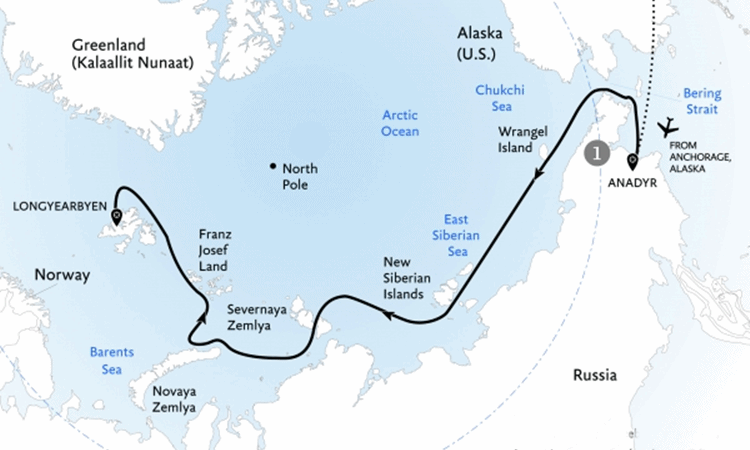
List of Russian icebreakers
Follows a list of all (including new) Russian icebreaking vessels (some currently under construction). In brackets is shown the scheduled year of launch.
- (nuclear ships operated by Atomflot/Rosmorport) - NS Rossiya (2027/Project 10510 "Leader"), NS Taymyr (1989), NS Vaygach (1990), NS Sovetskiy Soyuz (1990), NS Yamal (1992), NS 50 Let Pobedy (2007, NS Arktika (2020), NS Sibir (2021), NS Ural (2022), NS Yakutia (2024), NS Chukotka (2026), NS TBN2 (2030/Leader), NS TBN3 (2032/Leader)
- Admiral Makarov (FESCO)
- Akademik Fyodorov and Akademik Tryoshnikov (research vessels, AARI)
- Akademik Ioffe (fka "One Ocean Navigator" cruise ship, polar research vessel, RAS-Academy of Sciences)
- Akademik Vavilov (fka "One Ocean Voyager" cruise ship, polar research vessel, RAS-Academy of Sciences)
- Aleksey Chirikov, Vitus Bering, Yevgeny Primakov, Gennadiy Nevelskoy, Fedor Ushakov, Stepan Makarov (SCF-Sovcomflot icebreaking standby and supply vessels / IBSBV)
- Andrey Vilkitsky, Alexander Sannikov - Gazprom Neft icebreaking support vessels, project Aker ARC130A)
- Baltika (rescuer, Rosmorrechflot)
- Dikson (Rosmorport)
- Dudinka (Norilsk Nickel)
- Eisbrecher7 (2023) - under construction
- Krasin (FESCO)
- Magadan (FESCO)
- Moskva (Project 21900, Rosmorport, 2008-built)
- Mudyug (Rosmorport)
- Murmansk (Project 21900, Rosmorport, 2015-built)
- Novorossiysk (Project 21900, Rosmorport, 2016-built)
- Sankt Peterburg (Project 21900, Rosmorport, 2009-built)
- NS Sevmorput (icebreaking container ship, nuclear-powered)
- Viktor Chernomyrdin (diesel-powered, Rosmorport, 2018-built)
- Vladivostok (Project 21900, Rosmorport, 2015-built)
- Kapitan Dranitsyn (cruise ship, polar research vessel, AARI)
- Kapitan Khlebnikov (cruise ship, FESCO)
- Kapitan Nikolaev (Rosmorport)
- Kapitan Sorokin (Rosmorport)
- Ilya Muromets (Russian Navy/Project 21180)
- Yevpaty Kolovrat (Russian Navy/Project 21180M)
Russian river icebreakers
Next are reviewed smaller-sized vessels used for bay/habror and river ice-breaking services.
Kapitan Evdokimov-class (project 1191) river icebreakers
These sisterships belong to a series of all 8x "Kapitan Evdokimov"-class (project 1191) units.
- Avraamiy Zavenyagin (1984-built as "Kapitan Krylov"/Norilsk Nickel), since 2015 homeported in Dudinka (Krasnoyarsk Krai)
- Kapitan Babichev (1983/LORP JSC Yakutsk-Ленское объединённое речное пароходство)
- Kapitan Borodkin (1983/LORP JSC Yakutsk), Kapitan Chudinov (1983/Rosmorport), Kapitan Demidov (1984/Rosmorport), Kapitan Moshkin (1985/Rosmorport): Azov Sea from homeport Rostov-on-Don
- Kapitan Evdokimov (1983/Rosmorport), Dvina River-White Sea
- Kapitan Metsayk (1984/Rosmorport): Volga River-Caspian Sea from Astrakhan
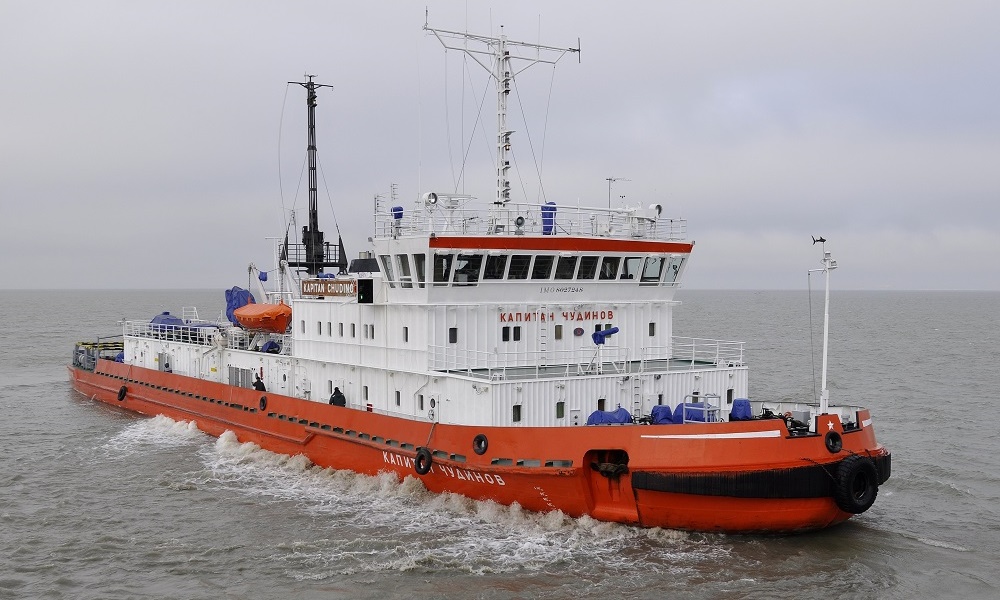
Each of these boats has Dining Room, Sauna, Helipad, and the following specifications:
- Builder: Hietalahti-Helsinki Shipyard (Finland)
- Speed: 14 kn / 26 kph / 16 mph
- LOA-length: 77 m / 253 ft
- Beam (width): 17 m / 56 ft
- GT: 1970 tons
- Crew: 25
- Max Draught: 2,6 m
- Displacement tonnage: 2340 tons
- DWT Deadweight tonnage: 328 tons
- ice-breaking capacity 1 m
- Powerplant: 3x Wartsila 12V22B diesel engines (combined 4,8 MW power output), 3x generators (combined 4,6 MW output), 4x propulsion motors (each 0,95 MW power output)
Kapitan Chechkin"-class (project 1105) river icebreakers
These sisterships belong to a series of all 6x "Kapitan Chechkin"-class (project 1105) units.
Project 1105 are of the type "river-sea" icebreakers, capable to operate in ice up to 1 meter thick. They are all equipped with a towing hook and intended for use at seaports in the south, west, and north of Russia. These icebreakers operate on Volga River, Neva River, Azov Sea and Baltic Sea (Gulf of Finland).
- Kapitan Bukaev (1978), Kapitan Chechkin (1977), Kapitan Chadaev (1978): Volga River-Caspian Sea shipping channel from Astrakhan
- Kapitan Plakhin (1977): Volga River from St Petersburg
- Kapitan Krutov (1978), Kapitan Zarubin (1978): Black Sea from Novorossiysk
Each of these boats has Dining Room, Sauna, Helipad, and the following specifications:
- Builder: Wаrtsilа Marine (Helsinki, Finland)
- Operator: Rosmorport
- Speed: 13 kn / 24 kph / 15 mph
- LOA-length: 78 m / 256 ft
- Beam (width): 17 m / 56 ft
- GT: 1600 tons
- Crew: 18
- Max Draught: 3,5 m
- Displacement tonnage: 2240 tons
- DWT Deadweight tonnage: 262 tons
- ice-breaking capacity 1 m
- Power output: 4720 kW
The next 3x sisterships are 1976-built (by Hietalahti-Helsinki Finland). Kapitan Izmaylov (Finland Gulf-Neva River from St Petersburg) and Kapitan Kosolapov (Dvina River-White Sea from Arkhangelsk) are owned by Rosmorport. Kapitan Radzhabov is owned by Azerbaijan (from Port Baku).
- Dining Room, Sauna, Helipad
- Max Draught: 4 m (13 ft)
- DWT tonnage: 354 tons
- ice-breaking capacity 1 m
- Powerplant: 4x Wartsila diesel engines (each 4 MW, or 16 MW combined power output), 2 electric motors (each 1270 kW/5,08 MW combined output)
List of British, Australian, American and Canadian icebreakers
In the following list, in brackets is shown the year of launch and the country that owns the vessel.
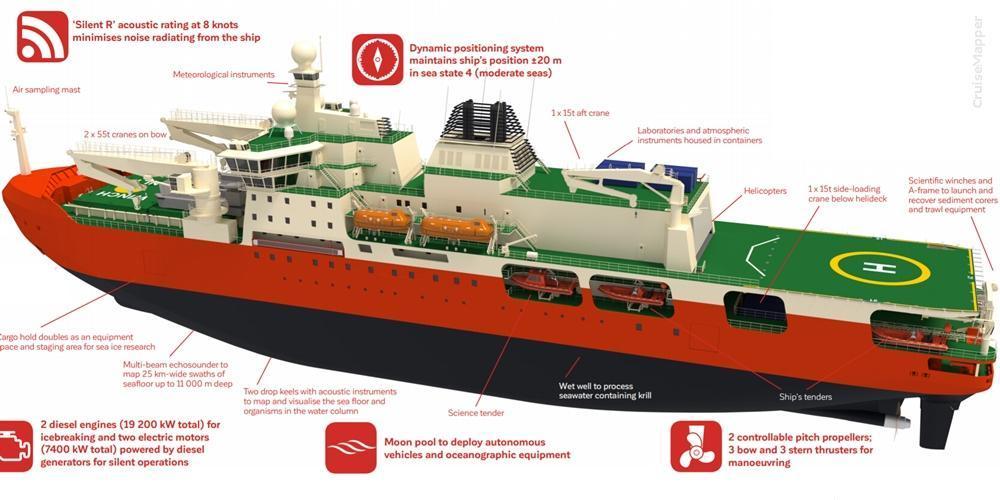
- Aurora Australis (1990, Australia)
- Nuyina (2020, Australia)
- Hudson (river icebreaker, Canada)
- Nathaniel B Palmer (1992, NSF)
- Laurence M Gould (1997, NSF)
- Sikuliaq (2014, NSF)
- Aiviq (2012, ECO - "Edison Chouest Offshore" - marine transportation companies, USA)
- RV Laura Bassi (1995, Italy)
- Noosfera (1991, Ukraine)
- RRS Sir David Attenborough (2021, BAS UK)
- CCGS Des Groseilliers (1982)
- CCGS Terry Fox (1983)
- CCGS Henry Larsen (1988)
- CCGS Pierre Radisson (1987)
- CCGS Samuel Risley (1985)
- CCGS George R Pearkes (1986)
- CCGS Kopit Hopson 1752 (1986)
- CCGS Martha L Black (1986)
- CCGS Sir Wilfrid Laurier (1986)
- CCGS Sir William Alexander (1987)
- CCGS Ann Harvey (1987)
- CCGS John G Diefenbaker (2029/new Polar Class 2)
- CCGS TBN (2030/new Polar Class 2)
- USCGC Healy (2000, cutter)
- USCGC Mackinaw (2006, cutter)
- USCGC Polar Sentinel (2025, cutter)
- USCGC Polar TBN1 (2026, cutter/Polar Class 2)
- USCGC Polar TBN2 (2027, cutter/Polar Class 2)
List of Icebreaking ships by other countries
In the following list, in brackets is shown the year of launch and the vessel's country.
- Aurora Borealis (European Union project)
- Araon (South Korea) 2009
- Ale (Sweden) 1973
- Elsava (river icebreaker, Germany)
- Frej (Sweden) 1975
- Kontio (Finland) 1987
- Kronprins Haakon (Norway) 2017
- MSV Botnica (Estonia) 1998
- MSV Fennica (Finland) 1993
- MSV Nordica (Finland) 1994
- L'Astrolabe (France) 2017
- Oden (Sweden) 1982
- Otso (Finland) 1985
- Polaris (Finland) 2016
- Polar Pevek (Norway) 2006
- Polarstern (Germany) 1982
- Shirase (Japan) 1983
- Sisu (Finland) 1976
- Urho (Finland) 1975
- Xue Long (China/"Snow Dragon") 1993
- Xue Long 2 (China/"Snow Dragon 2") 2019
- Ymer (Sweden) 1976
- (under construction, not named yet) project Arctech 510 (yard number NB 510, Finland)
- MT Mastera and MT Tempera (crude oil carriers - icebreaking tankers, Finland) - year-round crude oil shipping from Russia to Finland (Primorsk oil terminal to Porvoo and Naantali refineries of Neste Oil)*
In late November 2014, Finland's "Cabinet Committee on Economic Policy" released an official statement regarding the country's aging icebreaking fleet. According to the statement, the old fleet will be fully replaced with new icebreakers by the year 2029. Project's overall cost is approx EURO 1 billion. The new vessels (like Polaris) must be multipurpose icebreakers (including for Arctic oil explorations).
Follows a list of the ice-strengthened expedition and research vessels, which are often chartered for polar cruise itineraries to Arctic and Antarctic destinations.
- Akademik Golitsyn (1984, Russia)
- Akademik Shuleykin/Polar Pioneer (1985, Russia), Aurora Expeditions
- Akademik Shokalskiy (1982, Russia)
- Geolog Dmitriy Nalivkin (1983, Russia)
- MS Expedition (1972) owned by G-Adventures
- Professor Molchanov (1982, Russia)
- Professor Multanovskiy (1983, Russia)
- Professor Khromov (1984, Russia)
- Polar Empress (2015, Norway, GC Rieber Shipping)
- Polar Duke (2010, Norway, GC Rieber Shipping)
- Polar Duchess (2011, Norway, GC Rieber Shipping)
- Polar Marquis (2000, Norway, GC Rieber Shipping) - fka Geo Atlantic
- Polar Surveyor (1983) - fka Akademik Gamburtsye
- HMS Trosso (1984) - fka Arnold Veymer
- RRS Discovery (2013, NERC UK)
- RRS James Cook (2007, NERC UK)
- Stella Australis (2010) and Ventus Australis (2018) are owned by Australis Cruises Patagonia.
- Ushuaia (1970) is owned by Antarpply Expeditions.
- Oceanwide Expeditions own the ships Hondius (2019), Ortelius (1989), Plancius (1976), Noorderlicht (1991, 2-mast schooner), Rembrandt van Rijn (1994, 3-mast schooner).
- Quark Expeditions owns or charters the cruise vessels Island Sky (1992), Hans Hansson (1960), Sea Spirit (1991), Ocean Adventurer (1975 ), Ocean Atlantic (1986), Ocean Diamond (1974), Ocean Endeavour (1982), Ocean Nova (1992), World Explorer (2018).
- Magellan Explorer (2019) polar expedition vessel owned by Antarctica XXI
- Le Commandant Charcot (2021) polar superyacht owned by Ponant Cruises
zzz
Icebreakers related cruise news
- Cruise Industry
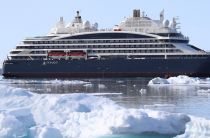
Ponant’s icebreaker Le Commandant Charcot sets sail for first-ever winter cruise along St. Lawrence...
An icebreaking cruise ship commenced its inaugural winter voyage along the St Lawrence River on Friday, January 17th, offering passengers a unique...
January 19, 2025 - Cruise Industry
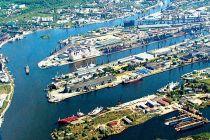
Krasnaya Kuznitsa (Russia) nears completion of icebreaking river ferries
Krasnaya Kuznitsa, a subsidiary of Russia’s state-owned United Shipbuilding Corporation/USC, has announced that two new ferries intended for...
January 14, 2025 - Cruise Industry
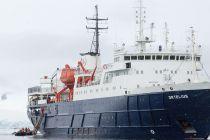
Oceanwide Expeditions triumphs in Weddell Sea despite challenging ice conditions
The expedition vessel mv Ortelius has successfully navigated the challenging waters of the Weddell Sea, enabling tourists to visit the emperor...
November 27, 2024 - Accidents

Le Commandant Charcot icebreaker’s visit to Lerwick halted by adverse weather
The season's final cruise ship call at Lerwick was canceled due to adverse weather, despite the vessel's classification as a polar exploration ship...
November 18, 2024 - Cruise Industry

MV Ortelius is first Antarctic expedition cruise ship (season 2024-2025) to enter Weddell Sea
Oceanwide Expeditions/fleet achieved a significant milestone for Antarctica 2024-2025 season, with its ice-strengthened cruise ship mv Ortelius...
November 16, 2024 - Cruise Industry

PONANT’s icebreaker Le Commandant Charcot becomes first to set foot on North Pole of Inaccessibility
Le Commandant Charcot has achieved a historic maritime milestone, becoming the first vessel to reach the North Pole of Inaccessibility under the...
September 23, 2024 - Cruise Industry

Bridgeman Services Group adds to its Floatel fleet Ocean Diamond cruise ship
Canada-based Bridgeman Services Group has expanded its portfolio of "floatel" accommodations with the acquisition of a retired cruise ship, aiming to...
April 3, 2024 - Accidents

New Russian ferry damaged by ice floes off Sakhalin Island
A new Russian ferryboat sustained hull damage from ice floes off Sakhalin Island, leaving 60+ passengers and crew stranded as they awaited assistance...
March 23, 2024 - Cruise Industry
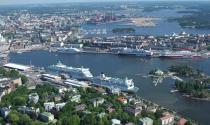
Davie Shipbuilding completes purchase of Helsinki Shipyard from Russian-owned Algador Holdings
Davie Shipbuilding, a Canadian firm, has successfully concluded its acquisition of Helsinki Shipyard, a manufacturer known for its production of...
November 8, 2023 - Cruise Industry

VIDEO: Ponant's Le Commandant Charcot meets Russia's nuclear icebreaker 50 Let Pobedy near North...
In the Russian Arctic, the 150-m icebreaking cruiser Le Commandant Charcot crossed paths with the Russian nuclear-powered icebreaker 50 Let Pobedy/50...
August 22, 2023 - show more news




